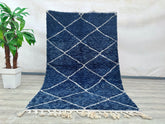Your guide to buying vintage and antique Moroccan rugs
Moroccan Rugs: A Blend of History, Art, and Functionality
Moroccan rugs are famous worldwide for their stunning designs, intricate craftsmanship, and rich cultural significance. They are more than just floor coverings – these handwoven pieces are works of art that bring warmth, color, and history to any space. Moroccan tribal women began weaving these rugs due to the abundance of wool from local sheep, using their creativity to craft unique designs that reflect their lives and traditions. These rugs are not only practical but also serve as blankets, seating, and even mattresses in the colder months.
The Cultural Importance of Moroccan Rugs
In Moroccan culture, these rugs were often given as wedding gifts and passed down through generations. Each rug tells a story, representing important events in the weaver's life, such as birth, marriage, and daily life. This is why Moroccan tribal rugs are filled with symbolism, making them both visually appealing and meaningful. Patterns and designs vary greatly depending on the region, showcasing the diversity of Moroccan craftsmanship.
Popular Moroccan Rug Styles
Some of the most well-known Moroccan rug patterns include:
-
Azilal Rugs: Known for their vibrant colors and bold designs.
-
Beni Mguild Rugs: Typically feature darker, richer tones.
-
Beni Ourain Rugs: Characterized by their ivory base and simple geometric patterns.
-
Boucherouite Rugs: Made from recycled fabrics, these are colorful and eco-friendly.
-
Kilim Pillows : These pillows, woven with traditional Kilim designs, offer a splash of Moroccan style to any room.
-
Tuareg Mats: Crafted from palm fibers and leather, ideal for adding a rustic touch.
Each of these styles showcases the diverse artistic expressions of Moroccan artisans and their mastery of weaving techniques.
Weaving Techniques of Vintage Rugs
The weaving process of vintage Moroccan rugs is done on simple, handmade looms by Berber women. These looms are often basic, constructed from wood and string. The weavers work in small spaces, only able to see a portion of the rug at a time. Superstitions prevent them from looking back at their previous work, forcing them to rely on memory, creativity, and instinct to complete the designs. This method results in unique rugs, where no two are exactly alike.
Understanding the Value of Moroccan Vintage Rugs
Each vintage Moroccan rug carries not only traditional tribal patterns but also personal stories. Women integrate symbols of fertility, nature, and their daily lives into the rugs, making each piece one-of-a-kind. The spontaneity and originality of the weaver's work contribute to the rug's authenticity and value.
Moroccan rugs are also functional, with thick piles for cold regions like the Atlas Mountains and flat designs for the desert. These rugs are practical as well as beautiful, often used as blankets, saddle covers, and sleeping mats.
Popular Moroccan Weaving Regions
Different regions in Morocco are known for their unique rug-making styles:
-
Fes: Famous for intricate floral designs and diamond patterns.
-
Rabat: Known for its coastal-influenced patterns and soft colors.
-
Beni Ourain: The Rif Mountain region produces some of the most recognizable rugs with simple diamond patterns.
-
Boujad: These rugs are vibrant and colorful, with abstract and artistic designs.
Unique Characteristics of Vintage Tribal Rugs
Moroccan tribal rugs are distinctive because of the specific symbols and patterns used by different tribes. Each tribe has its own weaving style that reflects their environment and traditions. For example, the Ait Ouaouzguite tribe is known for their silky wool and natural dyes, while the Ait BouIchaouen tribe’s rugs often tell stories through thick piles and vivid designs.
Collecting and Caring for Moroccan Rugs
Moroccan rugs, including handwoven Berber rugs and vintage Moroccan rugs, are highly collectible due to their uniqueness and cultural significance. They can be used as floor coverings, wall decor, or even table and bed coverings. Their versatility makes them desirable for interior design, and they add a rich, global touch to any home.
When selecting a Moroccan rug, look for quality materials such as wool from the Atlas Mountains. Wool is durable and eco-friendly, ensuring the rug will last for generations. It's important to care for these rugs properly, using spot cleaning or professional cleaning services to maintain their beauty.
Conclusion
Moroccan rugs are not only a testament to the rich history of Moroccan craftsmanship, but they are also versatile pieces of art that can transform any living space. Whether you choose a Beni Ourain, Azilal, or Boujad rug, you’ll be adding a piece of history and a story to your home. These handwoven rugs are a beautiful way to incorporate Moroccan culture and artistry into your decor.
Featured Products
169 x 251 cm = 5.5 x 8.2 ft moroccan wool rug, moroccan style rug, bohemian rug, handmade rug, outdoor patio, beniourain Rug, decor rug, Handmade Gift
- $599.00
$1,830.00- $599.00
- (-67%)
- Unit price
- / per
155 x 247 cm = 5.1 x 8.1 ft Diamonds Blue Soft Dots Berber Runner Rug - Handmade Moroccan Wool, Minimalist Design, Vintage Style, Perfect for Weddings & Bohemian Decor
- $599.00
$1,830.00- $599.00
- (-67%)
- Unit price
- / per










